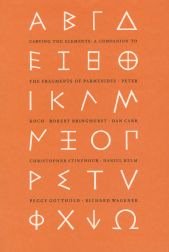Berkeley: Editions Koch, 2004. 6 x 9 inches. Paperback. 138 pages. First edition. This companion piece to The Fragments of Parmenides reveals the "blood, sweat and tears" the creators put into their original book. Carving the Elements tells the detailed story of the making of The Fragments of Parmenides, a grandiose book project meticulously crafted by: master letterpress printer Peter Koch; poet, translator and typographer Robert Bringhurst; punchcutter, type designer, typefounder and poet Dan Carr;..... READ MORE
Price:
$30.00
other currencies
Order nr. 78258
Robert Bringhurst
INTRODUCTION
Making a book is like making a child: nothing unusual or special. People do it every day. Yet it can make your skull and bones glow like a
light globe, cause the earth to lurch and sag beneath your feet, bring you nose to nose with the universe, and fuse your mind and body so
it seems as if they'll never come unglued. It can change your life. It can also change your history. This is the story of making a book:
not another (God help us) piece of writing about writing, but about the nitty-gritty: making a book, and getting made.
The text at the center of the enterprise is 2,500 years old, and give or take a decade, the first 2,500 years of its story are told in the
book itself; to which this is a companion. Let me pick up the story from there. Ten years ago, a thoughtful fisherman, printer and friend
named Peter Koch asked me to translate the fragments of Parmenides. It was not an invitation to take lightly. Peter is one of the few
living masters of the art of letterpress and the only one I know of who is seriously interested in the philosopher-poets of Pre socratic
Greece. He had already printed the fragments of Herakleitos the complete Greek text with Guy Davenport's deft and lean translation - in a
form that I greatly admired. So the bar was set at a difficult height, and shying away was out of the question. Though time and language
link the major Presocratics to each other, they remain distinctly different creatures, each with his own take on the universe and each with
his own voice. A good translation of one makes it that much more important, but also that much harder, to retranslate the next.
Discovering an honest typographic form for such pre-typographic texts is not a simple matter either. Peter commissioned two Greek types
for the project - a digital face designed by the Berkeley stonecutter Christopher Stinehour and a foundry face which Dan Carr cut by hand
in steel at Ashuelot, New Hampshire. To give the ancient text some youthful company, he also commissioned a series of brilliantly colored
abstract wood engravings from Richard Wagener in Santa Cruz.
Out of these and other components - a text, a transition, some paper, some plastic, some pigment and oil, some lead, some wood, some glue,
some linen thread (and not a little sweat, knowledge, money and expertise) - Peter and his gang made a book that is more thoroughly a book
than many other things that go by the same name.
We traveled freely across time, space and technological boundaries while working on this project. We used the latest tools as well as some
of the earliest. But the humanist enterprise remains just as physically demanding and mentally rewarding (and vice versa) as it ever was.
It was good to be reminded ( daily for years) that this is so.
The type was set by almost all the methods known. Richard Seibert and I set the ancient Greek by hand in Dan Carr's new foundry type.
Dan and his partner Julia Ferrari set the new transition in hot metal on their ancient (relatively speaking) Monotype machine. I set the
afterword on a laptop, using specially tooled Latin, Greek and Cyrillic digital fonts. Seibert translated the digital type into three
dimensions by photoengraving it into polymer. Wagener, meanwhile, was cutting all his images by hand in end grain wood and dreaming up
their colors. These components came together in Peter's hands in the bed of the press, where foundry metal, Monotype metal, polymer and
wood could all be inked and printed by hand, deep into paper made by hand at the Zerkall mill. Then there were the bindings. Daniel Kelm
bound twenty-six copies in full leather at his studio in Easthampton, Massachusetts. Peggy Gotthold bound another hundred and twenty in
quarter leather, and boxed them all in silk, at the Foolscap Press in Santa Cruz. The bindings, like everything else, were of course
constructed one by one, by hand. It was an exercise in carving steel, stone and wood and air - and in carving hexadecimals and hydrocarbon
polymer as well. But mostly it remains what it first was: an exercise in carving thought - primarily by hand.

